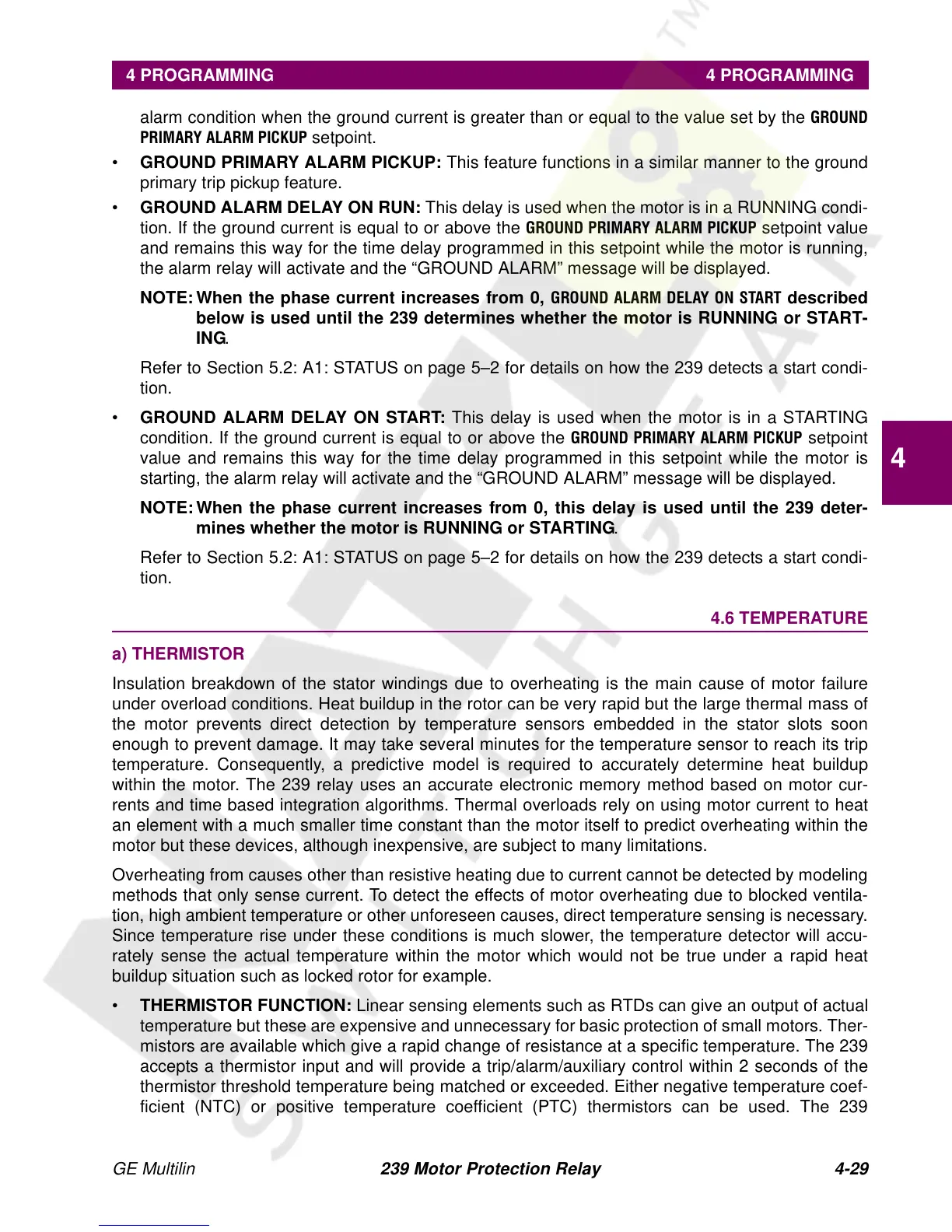GE Multilin 239 Motor Protection Relay 4-29
4 PROGRAMMING 4 PROGRAMMING
4
alarm condition when the ground current is greater than or equal to the value set by the *5281'
35,0$5<$/$503,&.83
setpoint.
• GROUND PRIMARY ALARM PICKUP: This feature functions in a similar manner to the ground
primary trip pickup feature.
• GROUND ALARM DELAY ON RUN: This delay is used when the motor is in a RUNNING condi-
tion. If the ground current is equal to or above the
*5281' 3 5,0$5< $/$50 3,&.83 setpoint value
and remains this way for the time delay programmed in this setpoint while the motor is running,
the alarm relay will activate and the “GROUND ALARM” message will be displayed.
NOTE:When the phase current increases from 0,
*5281' $/$50 '(/$< 21 67$57 described
below is used until the 239 determines whether the motor is RUNNING or START-
ING.
Refer to Section 5.2: A1: STATUS on page 5–2 for details on how the 239 detects a start condi-
tion.
• GROUND ALARM DELAY ON START: This delay is used when the motor is in a STARTING
condition. If the ground current is equal to or above the
*5281'35,0$5<$/$503,&.83 setpoint
value and remains this way for the time delay programmed in this setpoint while the motor is
starting, the alarm relay will activate and the “GROUND ALARM” message will be displayed.
NOTE:When the phase current increases from 0, this delay is used until the 239 deter-
mines whether the motor is RUNNING or STARTING.
Refer to Section 5.2: A1: STATUS on page 5–2 for details on how the 239 detects a start condi-
tion.
4.6 TEMPERATURE
a) THERMISTOR
Insulation breakdown of the stator windings due to overheating is the main cause of motor failure
under overload conditions. Heat buildup in the rotor can be very rapid but the large thermal mass of
the motor prevents direct detection by temperature sensors embedded in the stator slots soon
enough to prevent damage. It may take several minutes for the temperature sensor to reach its trip
temperature. Consequently, a predictive model is required to accurately determine heat buildup
within the motor. The 239 relay uses an accurate electronic memory method based on motor cur-
rents and time based integration algorithms. Thermal overloads rely on using motor current to heat
an element with a much smaller time constant than the motor itself to predict overheating within the
motor but these devices, although inexpensive, are subject to many limitations.
Overheating from causes other than resistive heating due to current cannot be detected by modeling
methods that only sense current. To detect the effects of motor overheating due to blocked ventila-
tion, high ambient temperature or other unforeseen causes, direct temperature sensing is necessary.
Since temperature rise under these conditions is much slower, the temperature detector will accu-
rately sense the actual temperature within the motor which would not be true under a rapid heat
buildup situation such as locked rotor for example.
• THERMISTOR FUNCTION: Linear sensing elements such as RTDs can give an output of actual
temperature but these are expensive and unnecessary for basic protection of small motors. Ther-
mistors are available which give a rapid change of resistance at a specific temperature. The 239
accepts a thermistor input and will provide a trip/alarm/auxiliary control within 2 seconds of the
thermistor threshold temperature being matched or exceeded. Either negative temperature coef-
ficient (NTC) or positive temperature coefficient (PTC) thermistors can be used. The 239

